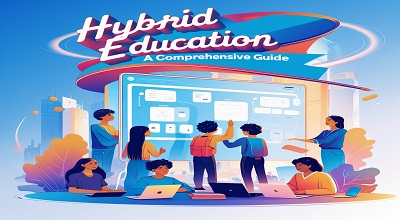Hybrid Education System
The hybrid education system, also known as blended learning, integrates traditional face-to-face classroom instruction with online learning experiences. This approach leverages the strengths of both methods to create a more flexible and effective educational environment.
Introduction
Hybrid education combines in-person teaching with digital resources, allowing students to engage with course materials both in the classroom and online. This model adapts to diverse learning styles and needs, providing a personalized educational experience.
Key Components of Hybrid Education
- Face-to-Face Instruction: Traditional classroom interactions where teachers and students engage directly.
- Online Learning: Digital platforms that offer lectures, assignments, and discussions accessible remotely.
- Integrated Curriculum: A cohesive program that seamlessly blends in-person and online elements.
Benefits of H-Edu
- Flexibility: Students can access materials and complete assignments at their own pace.
- Accessibility: Removes geographical barriers, making education available to a wider audience.
- Enhanced Engagement: Utilizes diverse teaching methods to maintain student interest.
- Resource Availability: Provides a wealth of online resources that can be revisited as needed.
Challenges of Hybrid Education
- Technological Requirements: Necessitates reliable internet access and digital devices.
- Self-Discipline: Students must manage their time effectively to keep up with online components.
- Instructor Training: Educators need to be proficient in both traditional and digital teaching methods.
Implementing Hybrid Education: Best Practices
- Clear Communication: Establish clear guidelines and expectations for both in-person and online activities.
- Interactive Content: Incorporate multimedia and interactive elements to enhance online learning.
- Regular Assessments: Use frequent evaluations to monitor student progress and adjust instruction accordingly.
- Student Support: Provide resources and assistance to help students navigate the hybrid model effectively.
Examples of Hybrid Education Models
- Flipped Classroom: Students review lecture materials online before class and engage in interactive activities during in-person sessions.
- Supplemental Online Courses: Traditional courses are supplemented with online modules to reinforce learning.
- Cohort-Based Learning: Groups of students progress through a combination of online and face-to-face sessions together.
Case Studies of Successful Hybrid Education Implementation
- University Level: Institutions offering hybrid courses have reported increased enrollment and improved student satisfaction.
- K-12 Education: Schools adopting blended learning models have observed enhanced student engagement and performance.
The Future of Hybrid Education
As technology continues to evolve, hybrid education is poised to become a standard approach in educational institutions worldwide. Its adaptability and accessibility make it a viable solution for meeting the diverse needs of learners in the digital age.
Conclusion
The hybrid education system offers a dynamic and flexible approach to learning, combining the best aspects of traditional and online education. By understanding its components, benefits, challenges, and implementation strategies, educators and students can effectively navigate and thrive in this blended learning environment.
Frequently Asked Questions (FAQs)
1. What is hybrid education?
Hybrid education, or blended learning, is an instructional approach that combines traditional face-to-face classroom methods with online educational materials and activities.
2. How does hybrid education differ from online education?
While online education is entirely virtual, hybrid education includes both in-person classroom experiences and online components, offering a mix of both learning environments.
3. What are the advantages of hybrid education for students?
Hybrid education provides flexibility, accessibility, and a personalized learning experience by combining the benefits of both traditional and online learning methods.
4. What challenges might students face in a hybrid education system?
Students may encounter challenges such as the need for self-discipline, time management skills, and access to reliable technology and internet connectivity.
5. How can educators effectively implement a hybrid education model?
Educators can implement hybrid education by integrating clear communication, interactive content, regular assessments, and providing adequate support to students.
6. Are there specific technologies required for hybrid education?
Yes, hybrid education often requires digital platforms for online learning, reliable internet access, and devices such as computers or tablets for students and educators.
7. Can hybrid education be applied to all educational levels?
Yes, hybrid education can be adapted to various educational levels, from K-12 to higher education, depending on the curriculum and learning objectives.
For more insights and resources on education, visit Teach Educator.
